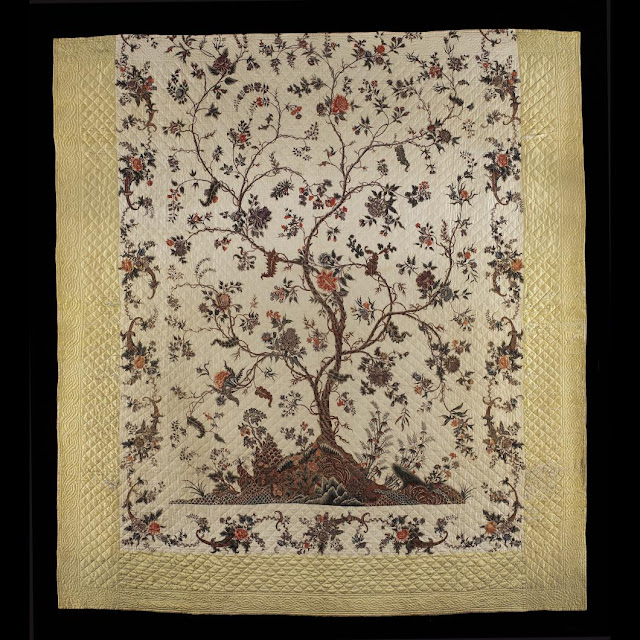The DeWitt Wallace Decorative Arts Museum at Colonial Williamsburg debuted a new exhibit last week, one that should appeal to anyone with an interest in fashion, fabrics, or design. Organized by Linda Baumgarten, Colonial Williamsburg's Senior Curator of Textiles and Costumes, Printed Fashions: Textiles for Clothing and Home presents an array of printed textiles, including an impressive selection of Indian Chintzes, that were made between 1700 and 1820. With an emphasis on printed cottons and linens that were used for both apparel and furnishings, the exhibit includes dresses, such as the c. 1790 frock seen above, bed coverings, and curtains.
I was not able to find much about the exhibit on the museum's website, but I did manage to find a video on YouTube that featured Baumgarten discussing the show. As the exhibit's textiles flashed onto my computer screen, I was reminded of how fashionable people of today continue this tradition of decorating their homes with printed fabrics, whose origins can be traced back to centuries-old chintzes. Take, for example, this c. 1770-1790 Indian Palampore quilt, which is surely the star of the Williamsburg exhibit:
Quilt, India (center panel) Europe (quilting), 1770-1790 Mordant-painted and resist-dyed cotton, silk Museum Purchase, 1930-690
I'm sure that most of us immediately think of Braquenié's much-loved tree of life print, Le Grand Genois:
Perhaps used most famously by Givenchy, the fabric has also been used to great effect by Caroline Sieber at her home in London...:
...as well as by designer Alessandra Branca at the 2015 Kips Bay Showhouse, where the fabric was made into a throw for a sofa.:
Also part of the exhibit is this chintz curtain panel, which dates to sometime between 1750 and 1790:
Curtain Panel India (center textile), France (borders), 1750-1790 Printed cottons, silk trimming Museum Purchase, 1937-165, 6A
The panel bears a striking resemblance to Ménars, a document print offered by Brunschwig & Fils...:
...which was memorably used for upholstery in Jayne Wrightsman's Palm Beach home, whose sumptuous interiors were assembled by Denning and Fourcade:
Any idea what the textile is below? It's a c. 1750-1775 barber's apron, which gentlemen wore to protect their clothes while being shaved or having their wigs powdered:
Barber's Apron, printed, 1750-1775, France (probably), Tabby cotton, block printed to form with pencil blue and overprint green. Museum Purchase, 1951-482
The apron's red flowers, reminiscent of poppies, brought to mind Robert Kime's oft-used poppy prints, including Opium Poppy:
and Field Poppy,...:
...with which Dallas designer Cathy Kincaid swathed this room, using yards and yards of it:
And last, but certainly not least, the exhibit includes yet another example of stylish attire, a banyan, which was a dressing gown worn by a gentleman. This example dates to the late eighteenth century or early nineteenth:
Man’s Banyan East Indian textile Worn in Britain, 1770-1790 mordant-painted and resist-dyed cotton, trimmed with silk Museum Purchase, 1954-1010
Again, my thoughts turned to Braquenié and its tree of life companion print:
which got the stamp of approval by designer and architect Daniel Romualdez, who enveloped his bedroom (located in the former Connecticut home of Bill Blass, no less) in both Braquenié prints:
As they say, everything old seems new again, especially when used in such stylish, classic ways.
Image at top: Woman’s Jacket and Petticoat East Indian textile, worn in New York, ca. 1790 from an earlier textile, Mordant-painted and resist-dyed cotton, lined with linen, reproduction kerchief Museum Purchase, 1990-10, 1-2
Image credit: Williamsburg images: Courtesy of the Art Museums of Colonial Williamsburg. Both the Sieber and Romualdez photos by Oberto Gili; Kincaid photo by Miguel Flores-Vianna.

























After looking at it a million times over the past couple decades, the Wrightsman upholstery still hits like a lightening bolt.
ReplyDeleteSo true. One of the highlights of late twentieth-century American design.
DeleteYet another example of how classic, good design is forever. Somehow I don't think we'll be seeing exhibits of things from Wayfair or HGTV in a retrospective or having influence for century. What a shame the young don't understand this anymore and only want the latest and trendiest.
ReplyDeleteYes, and all of this trendy stuff just ends up in landfills, so that's another strike against it, in my opinion.
DeleteThat Palampore quilt is beautiful! And banyans are such elegant loungewear. I wish men still wore them, and silk pyjamas, like Cary Grant. Alas, those days are gone. Now we get T-shirts and sweats :-(
ReplyDeleteWonderful post! Nothing is new under the sun.
Cynthia, Yes, banyans are so much more elegant than athletic wear!
DeleteI love these old and newer, Braquenie, prints. I hope that they come roaring back into the current design vocabulary. Maybe not a full fleshed as before, but always present. Thanks for making my week. Mary
ReplyDeleteMary, So glad you enjoyed the post! Have a nice week. :)
DeleteTres elegant. Jayne Wrightsman's Palm Beach home, WOW.
ReplyDeleteYes, her PB house was really something else!
DeleteHave you seen the new Longchamp Printemps collection? Totally Braquenie! https://youtu.be/HZ0hngV2udE
ReplyDeleteVery Braquenie! Cheerful, too. Thanks for the YouTube link. :)
DeleteThat's a fabulous plant in Daniel Romualdez's room. As well as a real lesson in how to use those exquisite fabrics.
ReplyDelete